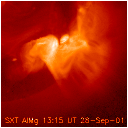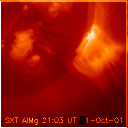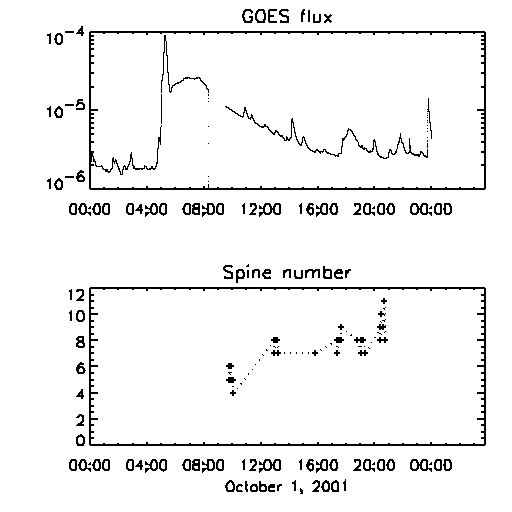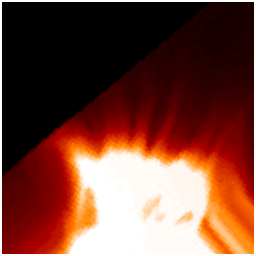
|

|
Yohkoh has seen multiple spiny arcades this week. "Arcade" refers to the nearly cylindrical array of coronal magnetic loops that long-duration flares often produce; check out the nugget search facility for "Bastille" and you will find one of the most exquisite examples displayed in several nuggets. During the early phase of a flare, these arcades often seem quite well-rounded and semicircular in cross-section. However, some of them tend strongly to become spiny later on. A pointy coronal streamer is a often called a "helmet streamer", but following this analogy a spiny arcade would be more like a whole platoon of Prussian soldiers wearing helmets with spikes.
Here's one of this week's beautiful spiny arcades (October 1, image on the right), compared with a quite comparable large event from three days earlier (image on the left):

|

|
In this nugget we discuss what we think the implications of a spiny arcade are. One important reason to be interested is that these regions are the sites of the SAD (= "Supra-Arcade Downflow") phenomenon, which must be related to large-scale magnetic reconnection in the corona during its relaxation from the flare explosion. See, of course, our earlier nugget on this subject and its links for background information.
We'd like to discuss the properties of the spiny arcades here, and make note of a few things:
The first event wasn't very spiny; note that its upper levels don't have clearly developed spines, but instead a sort of diffuse fuzz. Otherwise the events look quite similar and arise in the same activity complex. We believe, but haven't checked in detail, that both of these events corresponded to coronal dimming and huge CMEs. They had similar orientations and similar arcade brightnesses, so why was one spiny and one not?
By "homology" we mean the tendency of events to recur nearly identically. In these cases the corona supported two "restructurings" in the space of three days. We're puzzled by this theoretically, because a CME-producing restructuring must inherently be a dissipative process, and therefore could not recur identically any more than Humpty Dumpty could fall terminally off his wall twice (see a recent Dave Barry quote). On small scales, as with impulsive flares (and CMEs) this may make sense, because small-scale emerging flux could in principle provide the repeating pattern directly. But here we see scales that are improbable for emerging flux.
There is not much literature on these spiny arcades, and little knowledge of their properties. The as-yet-unexplained properties include the existence of a spine, its multiple occurrence, its timing relative to the flare, and its magnetic topology (yes, topology) during its SAD phase. See McKenzie's most recent paper on the subject for references. Since we are researchers here, we couldn't help doing something small but new for this nugget: we counted the spines as a function of time for the October 1 event.

Here we see that the number of spines (just a simple eyeball estimate) doesn't change very much. It might be increasing slightly as the event proceeds (note how long after the impulsive phase of the flare we are looking), but that may also be the result of the changing observing conditions; see the MPEG movie to get an appreciation for how the spines develop:

They wave around, they experience the flows (SADs) we mentioned before, they get taller, and yet they more or less retain their original distribution. Note that in the movie and in its still frame above, we've rotated the images so that the spines point upwards. This made it easier to count them but left some potentially confusing artifacts in the images, such as the edge of the CCD now tilted at an awkward 140-degree angle.
As usual, our new observations don't have complete explanations on the theoretical side. Although we don't know what causes the spininess (even though we can make cartoons of "patchy reconnection"), one simple and possibly OK idea for the spatial scale of the spines (ie, their number) is just that it results from the photospheric field structure, with regard for the simplification of this pattern expected from the height in the corona (argument of famed theorist E. Priest and others). However - if the plot above shows any variation with time, it is in the sense of increasing spine count as the event ages and becomes larger. Hmmm. We will return to this topic often, we have something here that probably is quite fundamental.
October 5, 2001